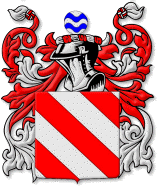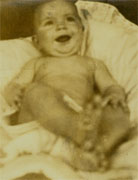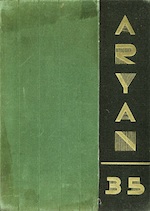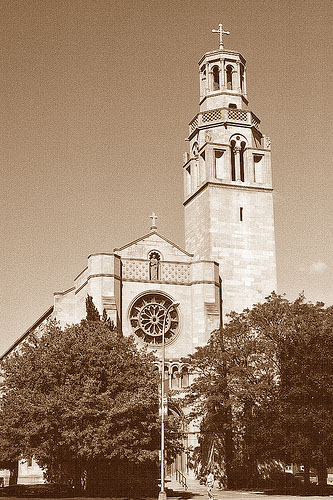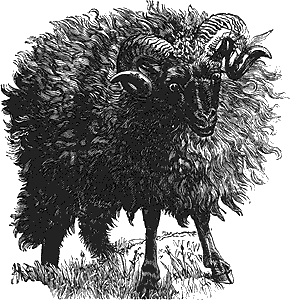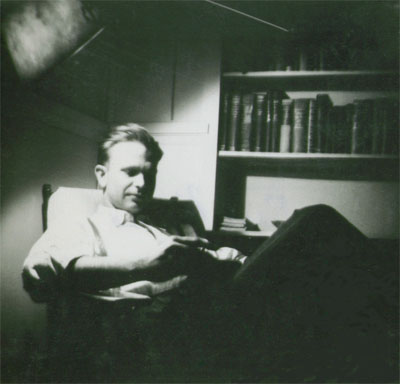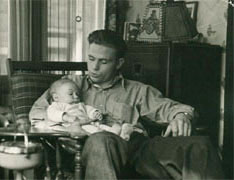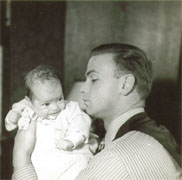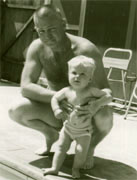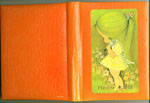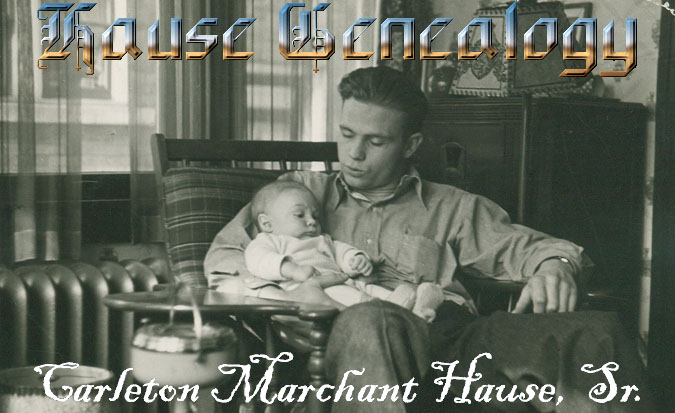 |
"There is science, logic, reason; there is thought verified by experience. And then there is California."
—Edward Abbey (American Writer, 1927-1989)
|
Bud grew to be a mountainous 6'4" man who loved the outdoors. Unlike his father Carlisle, he didn't like to hunt—but he did inherit his father's love of the water, and would live along the shores of a lake or river for most of his life, where he could fish while smoking his pipe and reading a good book—another one of his great loves (I still have his cherished Matt Helm paperback collection).
|
|
||||||||||||||||||||||||||||||||
Football aside, "Moonglow's" greatest preoccupation would become JEANNE MAY BRUNNER (5/17/1918 - 5/15/2000), whom he met while attending Michigan State Normal College (now Eastern Michigan University). She was going to Wayne State in Detroit, and family lore says they met at an inter-college party.
Jeanne appeared to be Bud's opposite in every respect: He was over six feet and husky, while she was barely five feet tall and extremely thin. He loved the outdoors, while she grew up in metropolitan Detroit, and preferred more refined, cultural pursuits. He was gregarious and a practical joker, while she was always very proper (she made a point of calling him "Carl," not "Bud" (let alone his high school nickname, "Moonglow"¹) and one of their grandchildren swears that later in life Jeanne used to return her cards and letters with spelling and grammatical errors circled and corrected in red ink.
But the chemistry between them was unmistakable, even in photographs:
 |
|
But the denomination of Carleton's (formerly Bud's) fiancée was Catholic—in fact, the Brunner family was extremely Catholic. They wanted the marriage to take place in the Brunner family's parish in Detroit, called St. Cecilia Church.³
At that time, the entire community in their area of Detroit revolved around the parish, which took up an entire block. Jeanne and her two sisters had gone to school there, and Father Wholihan had gotten Jeanne's father, Al, a prominent job as the Production Manager at Kelsey Hayes Wheel Company (which made all of the wheels for Ford automobiles). During the Depression, Al had worked at the plant for no salary and supported his family by creating Virgin Mary statues that he sold door-to-door.
The Hause family, for whatever reason, were historically not big Catholic supporters. (Remember, just 60 years before, the Laban Hause family had moved out of Emmett, Michigan, because it was "too Catholic"). But as a compromise, Carleton agreed to attend "Catholic classes" in order to be married in the Brunner family's church. But at these classes, he was informed that he'd have to convert to Catholicism. Carleton balked, so another compromise was offered: if Carleton wouldn't convert, he would need to agree to raise his children in the Catholic faith.
So Carleton, who didn't like being told what to do any more than Carlisle or Frank, weighed his options: He realized that every Hause and Brunner in Michigan had a certain expectation for this wedding, and so he answered all of them in the only way that seemed fair—on the 17 Aug 1938, he and Jeanne eloped to Indiana.
|
|
|
|||||||||||||||||||||||||||||||||||
One can only imagine how confusing it got living in one household with three Carls (thus signalling the end of that first name in our family line).
In 1940, Carlisle remarried, and Carelton moved Jeanne and Carleton, Jr., into an apartment in Ypsilanti. They lived on the 2nd floor of a house on Cross Street.
Jeanne stayed home while Carleton worked as a "Religious Artifact Collector," according to the 1940 Census. This was probably tied to his father-in-law, who had supported his family during the Depression by making and selling statues of the Virgin Mary door-to-door. Carl and Jeanne then added a second child, a daughter named after Carl's late mother:
CHILDREN OF CARLETON HAUSE AND JEANNE BRUNNER | |
| |
|
|
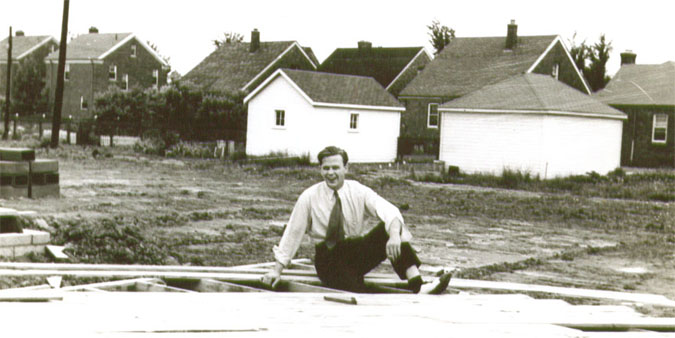 Carleton Marchant Hause steps into his first home (literally), in 1941. |
|
Work was also plentiful, as former Northville resident Henry Ford had purchased a factory there in 1919. Known as the Northville Valve Plant, it provided valves for every Ford, Mercury, and Lincoln vehicle, except for the Lincoln Continental.
But by this time, Carl had tired of factory work. It was drudgery, and the smoke and chemicals he inhaled couldn't have been any better for him than it was for the lake that the factory spewed all of its refuse into. So, following in the footsteps of his father, Carleton took a job as a teacher (as did Jeanne, who returned to college and earned her teaching credential after Marjorie started school). Carl Sr. taught English in Allen Park, Wayne County, while Jeanne taught the same course in in Rockwood, near Gibraltar, then in Riverview, between Trenton and Wyandotte.
Teaching offered less monotonous, more sociable work, and provided summers off to visit Vaughn Lake, where the elder Carl still presided over the cabin they had built together, while Gretchen and her family lived in the cottage next door. Then Carl Sr. started spending his summers in charge of the recreation program in Gibraltar.
|
|
Missing the water, Carleton and Jeanne then moved their family to the town of Gibraltar in Wayne County—which was in reality an interconnected group of islands at the edge of Lake Erie, strung together by a series of bridges. For the first couple of years they lived on the shore of a canal, then moved a few blocks away to a larger house on the shore of the lake. The house was also apparently the former residence of a bootlegger, because one day when Carl Sr. and Jr. were building a boat in the garage, Sr. leaned against the wall and it started to give. Exploring the problem, they discovered a hidden room filled with empty, unmarked whiskey bottles and old newspapers from the time of Prohibition.
Alcoholic drinks were still widely available at "speakeasies" and other underground drinking establishments. Meanwhile, whiskey was even available by prescription from medical doctors. The labels clearly warned that it was strictly for medicinal purposes and any other uses were illegal, but doctors freely wrote prescriptions and druggists filled them without question, and the number of "patients" increased dramatically. Over a million gallons were consumed per year through prescriptions. Well, up to now we've had black sheep head scalpers, kissin' cousins, and deadbeat dads, so of course the Hause family had its own Prohibition racketeer, too. In Marin County, California, a German whiskey smuggler named CARL HAUSE (not our line, I swear) did a brisk business. His operations were located on Point Reyes Peninsula, at the edge of Drake's Inlet, just south of Inverness. Carl was said to have buried approximately $500,000 in gold-backed currency somewhere between Inverness and the old Heims Ranch. However, he would not live to retrieve his ill-gotten gains as he was found shot to death in his car. The currency has never been found. (Wish we were related to him now?) |
|
Today people think of Southern California in the first half of the 20th Century as the home of Hollywood, and an entertainment mecca. But in the early Twentieth Century, the area was nothing but arid farmland and deserted goldmines, with lots of cheap, open space. The dry, sunny year-round climate made it perfect for filmmaking (because it's easier to film fake snow in the sun that it is to fake sunny weather in snow). But the climate and open space was also perfect for the development of industries that society found less glamorous—military bases, air strips for the newly-invented and ureliable airplane, and worst of all, wrap parties for Fatty Arbuckle. The vast emptiness of the desert became filled with both dreamers and exploiters. But after the Great Depression, the booming post-World War II economy (and the emerging Cold War) caused the U.S. government to pump unbelievable sums of money into the military industrial complex and the aerospace industry—which in turn caused a population explosion in Southern California (along with nuclear test explosions in Nevada and New Mexico).
In order to meet the demands of a growing high-tech economic boom, the state needed an educated, white collar class—which would in turn feed the money back into the economy with a disposable income. This created a need for more and better educators. There were lots of teaching positions available in California—and not only did the schools there pay better than those in Michigan, but both Carl and Jeanne could teach during the day and attend school at night to gain their credentials.
So in the late 1950's, Carl followed his Uncle "Dick" to Southern California. Dick had originally intrigued the family when he moved west with his new wife and sent a shipment or oranges to Frank and Fladella on their 50th wedding anniversary. In Memphis that news was big enough to even receive a mention in the newspaper! Carl and Jeanne found a society very different from Michigan's.
|
THE LAWS OF CALIFORNIA IN THE 20TH CENTURY: |
|
|
|
|
The family was reunited just in time for the Cuban Missile Crisis—with the aerospace industry and military presence so prominent in San Diego, the threat of a nuclear attack by Russia was taken very seriously. For instance, the Pierce family in nearby Encinitas lined the walls of their house with tin foil, in hopes of keeping out any radiation. Meanwhile, the various Hause families in Southern California all agreed to rendezvous at the desert trailer home of Raymond Hause when Commie missiles started dropping. Fortunately for the U.S. (and unfortunately for the tin-foil industry), the crisis ended after a couple of weeks. Life went back to normal—but the threat remained. Here is an excerpt from a Department of Defense booklet that Carl Jr. kept in his bookcase during the early 1960s. It contains brilliant scientific facts, brought to you from in-depth research by the military industrial complex:
|
FALLOUT PROTECTION: What to Know and Do about Nulear Attack |
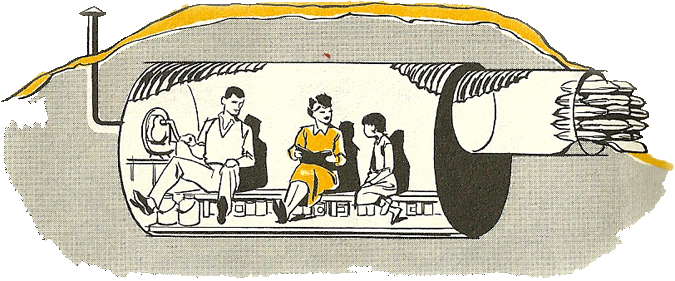 "This prefab backyard shelter for four can be bought for under $150. The price includes the corrugated steel-pipe unit (4-foot diameter), entry and air vent pipes."—FALLOUT PROTECTION: What to Know and Do about Nulear Attack, by the Department of Defense & Office of Civil Defense: December, 1961. |
Fortunately, the bombs never fell (at least in their lifetimes), and the desert rendezvous was never needed. After their long careers teaching in Michigan and California, Carl and Jeanne moved to Arizona and lived out their retirement years on the Colorado River, where Carl could live along the water like he had in Michigan: spending his time fishing, reading, and adoring his wife.
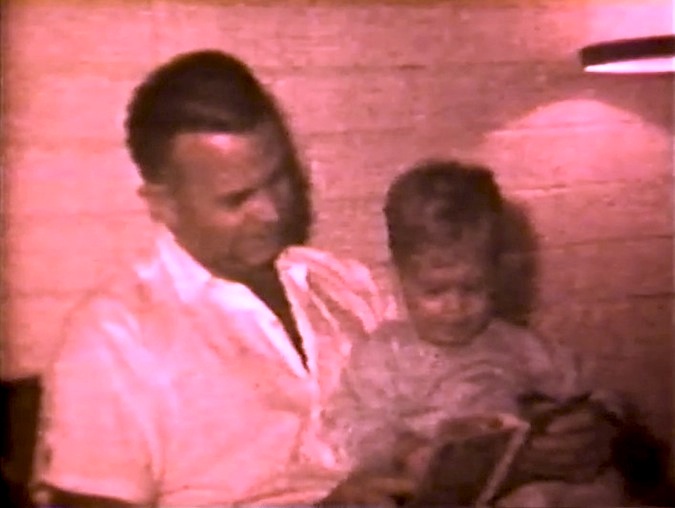 |
|
||||||||||||||||||||||||||
Now comes the point in the family history where I get to tell my favorite love story of all. Like all great love stories, it's framed in sadness: Grandpa was spending his final days with my Grandmother in a hotel near the hospital. He was on some extremely strong painkillers, which made him sleep—which he didn't want to do, because he wanted to stay awake with my Grandmother! (If you had ever met her you'd know she was worth it.) But Jeanne was the practical one, and wouldn't allow him to lie there in pain, so she forced him to take the medication: She stood over him—until it was gone. Then, finally, weeks later, he passed away . . . and when they disassembled his bed, they found a mound of pain tablets that he had stuffed behind the mattress—enduring unimaginable pain just to stay awake with his wife. Of all the stories in this family history, whether they involved war, or crossing the ocean in a veritable slave ship, or trailblazing in the frontier wilderness, I think this story is the bravest.
Upon his death, Carl, Sr., who had always loved living near the water, became one with the water, when his ashes were spread in the Pacific Ocean. Seventeen years later, Jeanne joined him, via the Neptune Society. Now whenever their descendants relax along the shores of the Pacific Ocean to fish or read a good book, they will look out on those sparkling waters and think of Carl Sr. and Jeanne, who brought the family to those shores so many years before.
 Carleton Marchant Hause, Jr., with Martha Ellen Wenk-Hause and their ancestors (the original front-page artwork for this site). |
John begat John, who begat William, who begat John, who begat Augustus, who begat Laban, who begat Frank, who begat Carlisle, who begat Carleton, who begat Carleton Jr., who begat me, who begat this family history...
NOTES ON THIS PAGE:
¹—"Moonglow" was a hit song for Benny Goodman in 1934, with music by Will Hudson and Irving Mills and words by Eddie DeLange. It's a syncopated foxtrot in 4/4 time, and was very popular. Sample lyrics: "It must have been moonglow, way up in the blue; It must have been moonglow that led me straight to you. I still hear you saying, 'Dear one, hold me fast.' And I start in praying; Oh Lord, please let this last." Fortunately, Benny's version was an instrumental. Anyway, Carl must have liked it, because he even signed his name as "Moonglow Hause" in the yearbook:
 |
²—The First Presbyterian Church of Detroit was built in 1889, and is located at 2930 Woodward Avenue in Detroit, Michigan. It is listed on the National Register of Historic Places and was designated a Michigan State Historic Site in 1979. The church is made from rough-cut red sandstone, with the floorplan in the shape of a Greek cross. Masonry arches support a red sandstone tower with a slate roof with turrets at each corner. The stained glass windows of the church are exceptional, with many of Tiffany glass. The building is currently used as the Ecumenical Theological Seminary.
³—Today, St. Cecilia considers itself an "urban house of worship." The neighborhood around the church today is extremely poor, with abandoned buildings surrounding the parish, and has fallen on very hard times. A church worker told Carl Hause, Jr., when he visited in 2006 that Rev. Theodore K. Parker "was the only good thing in the lives" of many local residents. St. Cecelia's is known outside of Detroit today for two reasons: A painting of the "Black Christ" in the apse dome, which was completed in 1968, and its indoor basketball court. Magic Johnson, Isiah Thomas, George Gervin, and Dave Bing all played at the church's small red brick gym, as did Michigan's "Fab Five." In fact, the scoreboard was donated by Jalen Rose. A sign over the front door reads, "Sports capital of Detroit." It became the epicenter of basketball in Detroit during its heyday in the 1980s and '90s, on a wood court donated by the NBA's Detroit Pistons. Mike Lopresti of USA Today wrote, "There were July nights that the Ceciliaville summer league might have had the best collection of basketball talent in the world." (Detroit's temple of basketball deserves salute, 1 Apr 2009). League founder Sam Washington "had his idea after Detroit's deadly riots in the 1960s, and from the debris of the fires, a basketball league arose. The church sought to appeal across racial and political boundaries. On one side of the street, basketball games in a gym built in the 1920s. On the other, Black Panthers meeting in the church basement."
|
CHAPTER 2: JOHN HAUSE OF WARWICK (1719-1794) CHAPTER 3: WILLIAM HAUSE (1750-1818) CHAPTER 4: JOHN HAUSE OF FAYETTE (1773-1844) CHAPTER 5: AUGUSTUS HAUSE (1804-1875) CHAPTER 6: LABAN AUGUSTUS HAUSE (1831-1906) CHAPTER 7: FRANK AUGUSTUS HAUSE (1867-1951) CHAPTER 8: TWENTIETH CENTURY MICHIGAN CHAPTER 9: CARLISLE HAUSE (1891-1972) CHAPTER 10: THE GREAT DEPRESSION CHAPTER 11: CARLETON MARCHANT HAUSE, SR. (1917-1983) CHAPTER 12: CARLETON MARCHANT HAUSE, JR. (1939-2014) CHAPTER 13: AFTERWARD - THE TWENTY-FIRST CENTURY
APPENDIX #1: ORIGINS OF THE HAUSE FAMILY APPENDIX #2: HAUSE FAMILY TIMELINE, 1690-PRESENT APPENDIX #3: WILLIAM HAUSE GENEALOGY, 1750-PRESENT APPENDIX #4: THE HAUSE FAMILY IN THE CIVIL WAR APPENDIX #5: HAUSE FAMILY BIBLES
ADDENDUM #1: THE HAUß FAMILY OF THE MOHAWK ADDENDUM #2: THE HAAS FAMILY OF SAARLAND ADDENDUM #3: MORE HAUSE / HAWES LINES ADDENDUM #4: DNA TESTING ADDENDUM #5: LINKS TO OTHER WEBSITES ADDENDUM #6: ABOUT THE AUTHOR 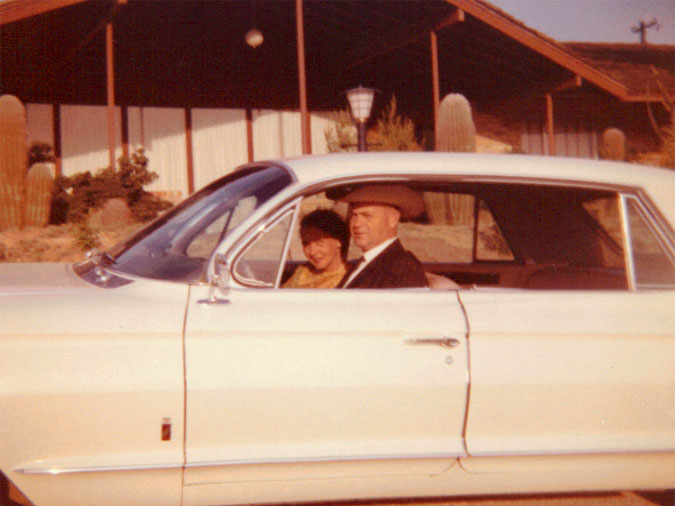
|
